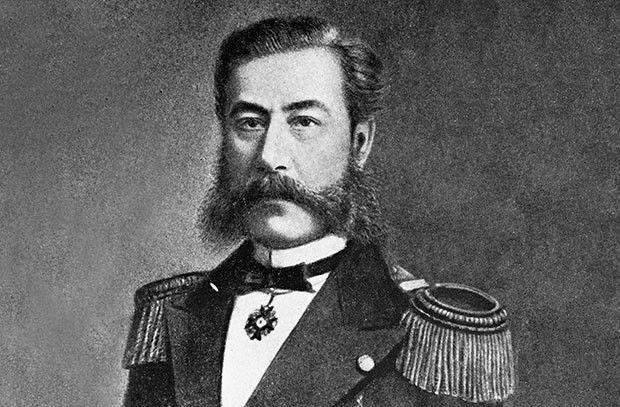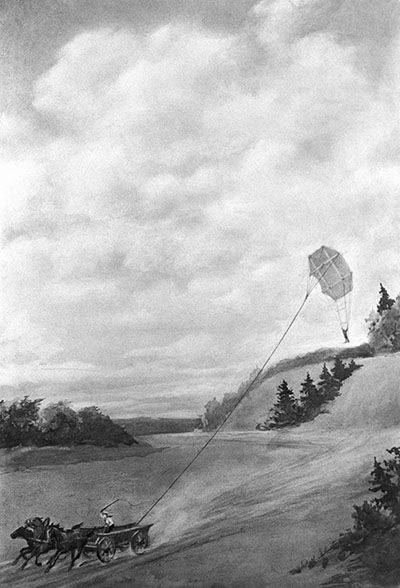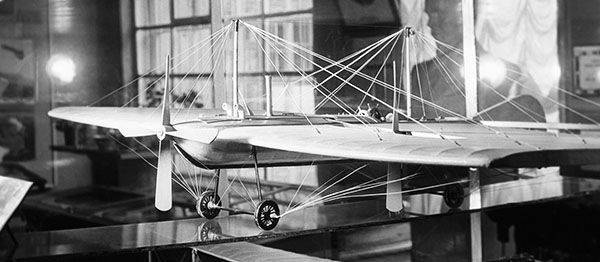Midshipmen, up!

Born in the era of sailing fleet, Alexander Mozhaisky opened the era of flying in the sky
In his youth, Alexander Fedorovich was a midshipman: the son of the admiral of the Russian fleet, he graduated from the Naval Cadet Corps in St. Petersburg. The future sailor and aeronaut was born 9 (21) in March 1825 of the year in Finland, and his childhood was spent traveling to the ports of the Baltic and the White Sea. At the age of ten, the parents brought the boy to the capital and sent him to the cadets. The director of the corps at that time was Ivan Fedorovich Kruzenshtern. The famous traveler, he not only knew and loved the maritime business, but also had a broad outlook, unlike many government officials, knowing full well that the development of the fleet requires restructuring the training of naval officers. Having created an officer class under the Marine Corps, he selected 6 – 8 honors from each issue to study in it. Future officers were given lectures on higher mathematics, astronomy, and the theory of shipbuilding. The famous German naturalist Alexander Humboldt, who visited St. Petersburg in 1829, exclaimed, having familiarized himself with the training program in this educational institution: “How happy I would be if I could know everything that the Russian cadet knows!”
Thanks to the reform carried out by Kruzenshtern, Alexander learned not only to be the captain, but also to the ship designer. For two years the young man “did practical work” - he walked on frigates “Melpomene”, “Olga”, “Alexander Nevsky”. So began his naval service. Seven years later, during which he sailed the White, Barents, Norwegian, Northern and Baltic Seas, increased the knowledge and practical experience of the seaman. In the 1849 year, when Mozhaisky was not yet 25 years old, he was made lieutenant. His personal qualities - technical skills, discipline and ability to lead a team - commented: Alexander was included in the crew of one of the first Russian military steamers - “Hard”. Recall that the officer service of Alexander Fedorovich came in the last years of the military sailing fleet: the Crimean war, which will break out soon, will demonstrate the superiority of steam engines.
In 1853 – 1855, Mozhaisky took part in long-distance navigation Kronstadt-Japan on the frigate Diana. The prehistory of the voyage is as follows: in 1852, from the Kronstadt raid, the frigate “Pallada” went to the distant and practically unknown Russian “Nippon country” —the same one whose journey the Russian classic Ivan Goncharov described. Six months later, one of the officers returned to Russia, reporting that the frigate had become unusable due to a storm. To replace the "Pallada" hastily equipped the "Diana", which went to its destination through the Atlantic and the Pacific Ocean (past Cape Horn). The frigate safely reached Japan, but could not return: during a tsunami in a bay near the island of Honshu, he received holes and sank. In the ship's log, the name of Mozhaysky is preserved as the name of the officer who last came down from the frigate to the ground.
To return to their homeland, the sailors under the leadership of Mozhaisky, with the help of the Japanese, built the schooner "Kheda", in which part of the navigators reached Russia. Mozhaysky himself went to Petropavlovsk-Kamchatsky on an American merchant ship, from there to the Amursky Liman, then returned to Kronstadt through Siberia, thus making a round-the-world trip. He arrived at his homeland in the midst of the Crimean War and soon received an appointment to the brig Antenor, guarding the approaches to the Gulf of Finland and preventing sabotage by British and French ships. After the war, the tsarist government was engaged in fleet technical re-equipment: the steam engines with which most of the enemy ships were equipped clearly showed that their sails had outlived their own. Acquaintance with the steam engine played an important role in the further fate of Mozhaisky, because it was the only engine that made it possible to build an aircraft heavier than air in the 19th century.
However, while he did not think about it yet. There was no time: after the war, Mozhaisky was sent as part of a Russian expedition to the Khiva Khanate - the empire was going to join these lands, and the expedition needed an experienced sailor who could explore the Aral Sea basin and the Amu Darya and Syr Darya rivers, assessing how suitable and important they are for navigation. And in 1863, his career as a naval sailor was interrupted for a long time: under the terms of the Paris Peace Treaty, Russia had to significantly reduce the fleet, and Mozhaisky, among many naval officers, went on forced leave. He went to Vologda, where he lived for several years. Here he became an official - a candidate of a mediator - and was engaged in the implementation of the "Provision on the peasant reform of the year 1861", which abolished serfdom.
Flushed with success
The idea of building a device heavier than air, capable of flying, was born to Alexander Fedorovich in 1856 year. Subsequently, his son said that the possibility of such a flight Mozhaisky thought, watching the birds. It is not excluded that the inventor suggested the effect of the air flow on the sail on the idea of a wing supported by air. In addition, Mozhaisky, of course, has repeatedly seen how sailors on ships launched a snake, throwing a tench — a rope — onto the shore with its help. It was from the snake that his experiments on the construction of aircraft began: in 1876, he designed a glider-kite, on which he made a series of flights on the estate of his late brother, located on the shores of the Southern Bug. The glider took off thanks to the vigorous running of three horses, dragging him on the rope. Flying a snake showed that a fixed-wing aircraft could be stable in the air. Mozhaisky was not the first to fly a glider: back in 1856, a Frenchman, Jean-Marie Le Brie, made an 200-meter flight on his “Artificial Albatross” glider over the sea beach. However, further experiments of the Russian inventor have become truly revolutionary.

Success inspired the inventor, but his thought was immediately at a dead end: you can’t use horses as an engine for aircraft. Mozhaisky began to build miniature models of vehicles that could fly on an autonomous engine. One of them was shown to the public in the Petersburg arena in 1876 - a small boat with two large rectangular wings, equipped with one nose screw and two screws on the wings, as well as four wheels. The screws actuated the crown spring. After Mozhaisky turned the key several times, the machine accelerated on the table and took off. When the spring plant was over, the boat smoothly sat on the sand, which was covered with the arena of the arena. The audience applauded, however, Mozhaisky did not know how to turn a toy into a real flying machine. The Letuchka (as he called his brainchild) showed the correctness of the aerodynamic calculations he carried out, and the thought of using a steam engine had already occurred to him, but for the construction of a serious apparatus several thousand rubles were needed, and he did not have that amount.
The most difficult part began - tacking thresholds of various departments and visits to influential dignitaries. At first, Mozhaisky asked the chairman of the aeronautical commission of the Military Ministry, Count Totleben, to allocate funds “for further research and experimentation both on the movement of the projected projectile and to determine the various data necessary for the rational and correct construction of all the components of such a shell”. To resolve the issue of allocating the required amount, a whole commission was gathered. It was composed of Dmitry Mendeleev, who was interested in aeronautics, who from the very beginning took the side of Mozhaisky. The Commission agreed to allocate the inventor 3 thousands of rubles. True, this amount was enough only to build a slightly larger model of the airplane. To build a full-fledged aircraft, Mozhaisky turned to the Main Engineering Department, asking for 18 895 rubles.
Note Mozhaisky contained detailed drawings of the aircraft, its description and mathematical calculations. The aircraft consisted of a cockpit in the form of a boat, which housed the engine and pilot, two fixed wings, a birdlike tail that served to change the direction of flight up and down, three screws and a cart on wheels, which played the role of the chassis. The engine was to consist of two steam engines with a total horsepower 30. Mozhaisky suggested that such an aircraft could be used for reconnaissance and bombing.
New commission project rejected. It is believed that this happened not without the influence of the agents of foreign intelligence services operating at the imperial court. However, the inventor did not give up, turning to the naval minister, Admiral Stepan Lesovsky, who was once his commander on the "Diana". Lesovsky petitioned the Minister of Finance about the release of Mozhaisk 5 thousand rubles, but managed to get only half the amount. For the money received, the inventor ordered two steam engines (20 and 10 horsepower) in England, which used kerosene as fuel, and brought them to St. Petersburg. The money ran out again, and Mozhaisky asked for help from the minister of the Imperial court of Count Hilarion Vorontsov-Dashkova, a personal friend of Alexander III. He directly appealed to the sovereign, but even his petition did not help - the emperor was frightened by the arguments of his surroundings: “It is dangerous, Your Majesty, to build an air-flying apparatus in Russia with public funds. Suddenly, some revolutionary will take advantage of them, they will encroach on your person from the sky? ”
As a result, the plane was built on the personal funds of Alexander Fedorovich: he had to sell or mortgage everything he owned, right down to the wedding rings and the dinner service. Relatives, comrades and enthusiasts helped - most of the amount, for example, was sent by 1877 – 1878, the hero of the Russian-Turkish war, Mikhail Skobelev.
Firebird burnt in flames
In the summer of 1882, the unit weighing 57 pounds (about 934 kg), called the Mozhaisk "Firebird", was ready. For him, even built a "runway" - a long inclined wooden flooring on the Military Field in the Red Selo. Tests were conducted in the presence of representatives of the military department and the Russian Technical Society. The plane was tested by a mechanic who helped the inventor (the Mozhaisk himself was not allowed to fly because of his age - he was already 57 years old).
What happened next? Surprisingly, this cannot be said for sure: the fact is that the military department required complete secrecy from test organizers, therefore no documents with fixed results were preserved. In later sources (late XIX century), the test picture was described as follows: the plane took off and, flying a dozen meters in a straight line, began to land, damaging the wing (the pilot also suffered). However, the tests were considered successful, because the unit really flew.

No reliable sources have been preserved that could certify that Mozhaisky’s plane really took off. If so, then we can be proud that the world's first plane to fly with a person on board was created by a Russian. In Soviet times, engineers have repeatedly tried to solve this historical the problem is experimental - they built various models of Mozhaisky aircraft. However, a fundamental difficulty also arises here: the surviving drawings do not allow us to recreate an exact copy of the aircraft and to establish whether its technical characteristics were sufficient for it to take off. The most ambitious studies were conducted in 1979-1981 at TsAGI. Engineers built the model at a scale of 1:20, taking into account all the most important technical details. The model was purged in a wind tunnel. It was found that takeoff and horizontal flight would require more than two times more engine power - 75 “horses”. And yet, the engineers could not finally solve the problem. It was noted that the oncoming gust of wind at a speed of about 6-7 m / s was quite sufficient so that the apparatus could rise into the air and then plan. It was hardly possible to control it, but if so, it was indeed the first device in history to be heavier than air, which was able, although for a short time, to leave the sinful earth.
Immediately after the tests, Mozhaisky began to improve the design of the aircraft, again requesting the necessary amount from the Military Ministry. However, the officials gave him a surprisingly illiterate answer: referring to the statement of the American mathematician and astronomer Simon Newcomb, who allegedly proved that the device was heavier than air and could not fly, they spoke in favor of stopping funding for such studies. In spite of everything, Mozhaisky was going to continue his experiments - he planned to sell his estates in the Vologda province and in Ukraine, but he did not have time to finish the work - he died in extreme need on the night of March 20 of 1 of April.
The brainchild of Mozhaysky was waiting for a sad fate: after the death of the designer, his plane for many years stood in the open air in Krasnoye Selo, gradually collapsing. Then it was disassembled and transported to the Mozhaisky estate near Vologda, where it burned down in 1895 during a fire. Aircraft created by Western pioneers aviation, are still kept in museums, and the creation of the domestic pioneer has been lost forever - the bogeyman officials still maintained "strict secrecy" around the first aircraft in Russia, which ultimately lost both its models and most of the drawings.
Information